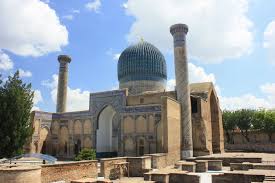Gur-e-Amir, Uzbekistan
🕌 Gur-e-Amir: The Majestic Tomb of Tamerlane 🕌
In the heart of Samarkand lies Gur-e-Amir, the stunning mausoleum of Amir Timur (Tamerlane) — one of history's greatest conquerors. Cloaked in deep blue tiles and crowned by an awe-inspiring ribbed dome, Gur-e-Amir is more than just a tomb; it is the birthplace of monumental Islamic architecture across Central and South Asia.
Standing before Gur-e-Amir, you feel the weight of centuries, the ambition of empires, and the haunting stillness of eternal rest.
🌟 Highlights of Gur-e-Amir 🌟
-
The Monumental Dome:
One of the most beautiful examples of Timurid architecture, the deep blue dome, soaring 32 meters high, is covered with radiant turquoise tiles and intricate golden calligraphy. It later inspired Mughal masterpieces like Humayun’s Tomb and the Taj Mahal. -
The Chamber of Greats:
Inside, beneath the glittering muqarnas (stalactite vaulting), lies the resting place of Amir Timur, along with his sons, grandsons, and his spiritual advisor. -
The Legendary Jade Tombstone:
Timur's tomb is marked by a massive piece of dark green nephrite jade — once the largest jade stone in the world. -
Mystical Legends:
According to legend, when Soviet archaeologists opened Timur's tomb in 1941, an inscription warned:
“Whosoever disturbs my tomb will unleash an invader more terrible than I.”
Two days later, Nazi Germany invaded the Soviet Union.
🏺 Historical Importance 🏺
-
Architectural Legacy:
Gur-e-Amir set the standard for Islamic mausoleum architecture across Central and South Asia. -
Symbol of Power:
Timur intended to be remembered forever, and this dazzling structure certainly fulfills that ambition. -
Family Necropolis:
Besides Timur, notable figures such as Ulugh Beg, the famed astronomer-king, are also interred here.
📸 Best Photo Spots 📸
-
Sunrise shots of the glowing blue dome.
-
Detailed close-ups of golden ceilings inside the tomb.
-
Wide-angle views capturing the magnificent portal entrance (iwan).
🌸 Best Time to Visit 🌸
-
Early morning or late evening provides the best light for photos and the most tranquil atmosphere.
-
Spring (April–May) and autumn (September–October) offer the most comfortable weather.
🚶 Tips for Visiting 🚶
-
Combine Gur-e-Amir with visits to Registan Square and Bibi-Khanym Mosque for a full day of breathtaking Timurid history.
-
Hire a local guide to fully appreciate the rich symbolism and legends hidden in the structure.
✨ Fun Facts About Gur-e-Amir ✨
-
Gur-e-Amir translates to "Tomb of the King" in Persian.
-
Timur was initially supposed to be buried in his hometown of Shahrisabz, but due to impassable snowy roads, he was laid to rest in Samarkand instead.
-
The tomb’s elegant proportions and exquisite decorations make it one of the most copied designs in Islamic architecture history.


